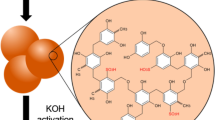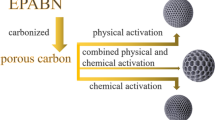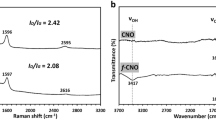Abstract
Porous electrode materials with large surface area and suitable pore size, as well as short diffusion distance of electrolyte ions in pore channels are desiderated for supercapacitor applications. Herein, we reported the synthesis of mesoporous activated carbon spheres (MACSs) that were obtained by the activation of resorcinol-formaldehyde (RF) resin using ZnCl2 as the activating agent. The spherical morphology of MACSs was characterized by scanning electron microscopy and transmission electron microscopy observations, and the well-developed mesoporous network (∼2.73 nm), high BET specific surface area (up to 2437.1 m2 g−1), and total pore volume (1.37 cm3 g−1) were obtained by a nitrogen sorption technique. Electrochemical measurements showed the excellent capacitive performance of MACSs and small internal resistance. It presented maximum specific capacitance value of 204 F g−1 for MACS-8 in 2 M KOH aqueous solution at a current density of 0.5 A g−1 and still remained 126 F g−1 at large current density as 20 A g−1, which well met the practical requirements of supercapacitors. Besides, the electrode material also demonstrated prominent long-cycling stability without any capacity loss after 5000 cycles.






Similar content being viewed by others
References
Kim TY, Jung G, Yoo S, Suh KS, Ruoff RS (2013) Activated graphene-based carbons as supercapacitor electrodes with macro- and mesopores. ACS Nano 7:6899–6905
Wei L, Sevilla M, Fuertes AB, Mokaya R, Yushin G (2012) Polypyrrole-derived activated carbons for high-performance electrical double-layer capacitors with ionic liquid electrolyte. Adv Funct Mater 22:827–834
Wang Y, Shi Z, Huang Y, Ma Y, Wang C, Chen M, Chen Y (2009) Supercapacitor devices based on graphene materials. J Phys Chem C 113:13103–13107
Zhang J, Lee JW (2014) Supercapacitor electrodes derived from carbon dioxide. ACS Sustain Chem Eng 2:735–740
Ruiz V, Pandolfo AG (2011) High-frequency carbon supercapacitors from polyfurfuryl alcohol. J Power Sources 196:7816–7822
Liu C, Yu Z, Neff D, Zhamu A, Jang BZ (2010) Graphene-based supercapacitor with an ultrahigh energy density. Nano Lett 10:4863–4868
Zhou X, Li L, Dong S, Chen X, Han P, Xu H, Yao J, Shang C, Liu Z, Cui G (2012) A renewable bamboo carbon/polyaniline composite for a high-performance supercapacitor electrode material. J Solid State Electrochem 16:877–882
Li M, Liu C, Cao H, Zhao H, Zhang Y, Fan Z (2014) KOH self-templating synthesis of three-dimensional hierarchical porous carbon materials for high performance supercapacitors. J Mater Chem Res A 2:14844–14851
Zhu Y, Murali S, Stoller MD, Ganesh KJ, Cai W, Ferreira PJ, Pirkle A, Wallace RM, Cychosz KA, Thommes M, Su D, Stach EA, Ruoff RS (2011) Carbon-based supercapacitors produced by activation of graphene. Science 332:1537–1541
Tan Y, Xu C, Chen G, Liu Z, Ma M, **e Q, Zheng N, Yao S (2013) Synthesis of ultrathin nitrogen-doped graphitic carbon nanocages as advanced electrode materials for supercapacitor. ACS Appl Mater Interfaces 5:2241–2248
Sevilla M, Fuertes AB (2014) Direct synthesis of highly porous interconnected carbon nanosheets and their application as high-performance supercapacitors. ACS Nano 8:5069–5078
Wahid M, Puthusseri D, Phase D, Ogale S (2014) Enhanced capacitance retention in a supercapacitor made of carbon from sugarcane bagasse by hydrothermal pretreatment. Energy Fuels 28:4233–4240
Mishra AK, Ramaprabhu S (2011) Functionalized graphene-based nanocomposites for supercapacitor application. J Phys Chem C 115:14006–14013
** YZ, Kim YJ, Gao C, Zhu YQ, Huczko A, Endo M, Kroto HW (2006) High temperature annealing effects on carbon spheres and their applications as anode materials in Li-ion secondary battery. Carbon 44:724–729
Lin JH, Ko TH, Lin YH, Pan CK (2009) Various treated conditions to prepare porous activated carbon fiber for application in supercapacitor electrodes. Energy Fuels 23:4668–4677
Zhao Y, Liu M, Gan L, Ma X, Zhu D, Xu Z, Chen L (2014) Ultramicroporous carbon nanoparticles for the high-performance electrical double-layer capacitor electrode. Energy Fuels 28:1561–1568
Zhao Y, Liu M, Deng X, Miao L, Tripathi PK, Ma X, Zhu D, Xu Z, Hao Z, Gan L (2015) Nitrogen-functionalized microporous carbon nanoparticles for high performance supercapacitor electrode. Electrochim Acta 153:448–455
Wang K, Wang Y, Wang Y, Hosono E, Zhou H (2009) Mesoporous carbon nanofibers for supercapacitor application. J Phys Chem C 113:1093–1097
Li W, Zhang F, Dou Y, Wu Z, Liu H, Qian X, Gu D, **a Y, Tu B, Zhao D (2011) A self-template strategy for the synthesis of mesoporous carbon nanofibers as advanced supercapacitor electrodes. Adv Energy Mater 1:382–386
Pol VG, Shrestha LK, Ariga K (2014) Tunable, functional carbon spheres derived from rapid synthesis of resorcinol-formaldehyde resins. ACS Appl Mater Interfaces 6:10649–10655
Ma X, Liu M, Gan L, Zhao Y, Chen L (2013) Synthesis of micro- and mesoporous carbon spheres for supercapacitor electrode. J Solid State Electrochem 17:2293–2301
Zhang LL, Zhao XS (2009) Carbon-based materials as supercapacitor electrodes. Chem Soc Rev 38:2520–2531
Yin H, Lu B, Xu Y, Tang D, Mao X, **ao W, Wang D, Alshawabkeh AN (2014) Harvesting capacitive carbon by carbonization of waste biomass in molten salts. Environ Sci Technol 48:8101–8108
Zhai D, Du H, Li B, Zhu Y, Kang F (2011) Porous graphitic carbons prepared by combining chemical activation with catalytic graphitization. Carbon 49:725–736
Yuan DS, Zeng J, Chen J, Liu Y (2009) Highly ordered mesoporous carbon synthesized via in situ template for supercapacitors. Int J Electrochem Sci 4:562–570
Liang Y, Wu D, Fu R (2009) Preparation and electrochemical performance of novel ordered mesoporous carbon with an interconnected channel structure. Langmuir 25:7783–7785
Wen ZB, Qu QT, Gao Q, Zheng XW, Hu ZH, Wu YP, Liu YF, Wang XJ (2009) An activated carbon with high capacitance from carbonization of a resorcinol-formaldehyde resin. Electrochem Commun 11:715–718
Yamada H, Nakamura H, Nakahara F, Moriguchi I, Kudo T (2007) Electrochemical study of high electrochemical double layer capacitance of ordered porous carbons with both meso/macropores and micropores. J Phys Chem C 111:227–233
Dai Y, Jiang H, Hu Y, Fu Y, Li C (2014) Controlled synthesis of ultrathin hollow mesoporous carbon nanospheres for supercapacitor applications. Ind Eng Chem Res 53:3125–3130
Hao L, Li X, Zhi L (2013) Carbonaceous electrode materials for supercapacitors. Adv Mater 25:3899–3904
Wang DW, Li F, Liu M, Lu GQ, Cheng HM (2008) 3D aperiodic hierarchical porous graphitic carbon materials for high-rate electrochemical capacitive energy storage. Angew Chem Int Ed 47:373–376
Feng D, Lv Y, Wu Z, Dou Y, Han L, Sun Z, **a Y, Zheng G, Zhao D (2011) Free-standing mesoporous carbon thin films with highly ordered pore architectures for nanodevices. J Am Chem Soc 133:15148–15156
Le VT, Kim H, Ghosh A, Kim J, Chang J, Vu QA, Pham DT, Lee JH, Kim SW, Lee YH (2013) Coaxial fiber supercapacitor using all-carbon material electrodes. ACS Nano 7:5940–5947
Yue Z, Mangun CL, Economy J (2002) Preparation of fibrous porous materials by chemical activation: 1. ZnCl2 activation of polymer-coated fibers. Carbon 40:1181–1191
Ma X, Gan L, Liu M, Tripathi PK, Zhao Y, Xu Z, Zhu D, Chen L (2014) Mesoporous size controllable carbon microspheres and their electrochemical performance for supercapacitor electrodes. J Mater Chem A 2:8407–8415
**ong W, Liu M, Gan L, Lv Y, Li Y, Yang L, Xu Z, Hao Z, Liu H, Chen L (2011) A novel synthesis of mesoporous carbon microspheres for supercapacitor electrodes. J Power Sources 196:10461–10464
Liu J, Qiao SZ, Liu H, Chen J, Orpe A, Zhao D, Lu GQ (2011) Extension of the stöber method to the preparation of monodisperse resorcinol-formaldehyde resin polymer and carbon spheres. Angew Chem Int Ed 50:5947–5951
Chang B, Guan D, Tian Y, Yang Z, Dong X (2013) Convenient synthesis of porous carbon nanospheres with tunable pore structure and excellent adsorption capacity. J Hazard Mater 262:256–264
Khalili NR, Campbell M, Sandi G, Golas J (2000) Production of micro- and mesoporous activated carbon from paper mill sludge I. effect of zinc chloride activation. Carbon 38:1905–1915
Chang B, Wang Y, Pei K, Yang S, Dong X (2014) ZnCl2-activated porous carbon spheres with high surface area and superior mesoporous structure as an efficient supercapacitor electrode. RSC Adv 4:40546–40552
Zhao X, Tian H, Zhu M, Tian K, Wang JJ, Kang F, Outlaw RA (2009) Carbon nanosheets as the electrode material in supercapacitors. J Power Sources 194:1208–1212
Li L, Song H, Chen X (2006) Pore characteristics and electrochemical performance of ordered mesoporous carbons for electric double-layer capacitors. Electrochim Acta 51:5715–5720
Kim C, Ngoc BTN, Yang KS, Kojima M, Kim YA, Kim YJ, Endo M, Yang SC (2007) Self-sustained thin webs consisting of porous carbon nanofibers for supercapacitors via the electrospinning of polyacrylonitrile solutions containing zinc chloride. Adv Mater 19:2341–2346
He X, Li R, Han J, Yu M, Wu M (2013) Facile preparation of mesoporous carbons for supercapacitors by one-step microwave-assisted ZnCl2 activation. Mater Lett 94:158–160
Acknowledgments
The authors gratefully acknowledge the financial support from 521 talent project of ZSTU, the program of Graduate Innovation Research in ZSTU (YCX13001), and the project-sponsored by the Scientific Research Foundation (SRF) for the Returned Overseas Chinese Scholars (ROCS), State Education Ministry (SEM).
Author information
Authors and Affiliations
Corresponding author
Electronic supplementary material
Below is the link to the electronic supplementary material.
ESM 1
The comparison of structure and performance of different porous carbon materials are listed in Table S1 in supplementary data. The comparison of TEM images for MACSs is utilized in Fig. S1. The textural parameters of CS-KOH can be seen in Table S2 and the comparison of electrochemical properties for MACS-8 and CS-KOH (Fig. S2) is also listed. (DOC 5675 kb)
Rights and permissions
About this article
Cite this article
Wang, Y., Chang, B., Guan, D. et al. Mesoporous activated carbon spheres derived from resorcinol-formaldehyde resin with high performance for supercapacitors. J Solid State Electrochem 19, 1783–1791 (2015). https://doi.org/10.1007/s10008-015-2789-8
Received:
Revised:
Accepted:
Published:
Issue Date:
DOI: https://doi.org/10.1007/s10008-015-2789-8




